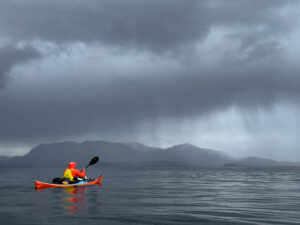For over 200 years, several sheets of notated music lay silent in a Spanish museum — until now.
In a recent lecture from the Sealaska Heritage Institute (SHI), humans played and heard the Tlingit tunes for the first time since 1791.
The music, it turned out, constituted a method of communication between the indigenous peoples and the exploring Spaniards. To hear two songs from the lecture, click on the video below.
Tlingit people hail from the far Pacific Northwest coast, indigenous to the islands and coastal lands of southern Alaska. Their traditional lands stretch around 700km from Yakutat Bay to Cape Fox.
In 1791, Tlingits in Yakutat Bay greeted two ships from Alejandro Malaspina and Jose de Bustamante’s expedition for King Charles IV of Spain.
One way the two disparate cultures got along was by singing. The Tlingit people sang “to and with” the Spanish sailors on several occasions during the visit, according to the SHI. Tadeo Haenke, a member of the crew who had musical training, documented the singalongs in his journals.

Tadeo Haenke. Photo: Wiki Commons
Haenke was a botanist first, but his musical acumen allowed him to translate the Tlingit singing into four sheets of music. Those sheets remained ensconced at a museum in Spain until recently, Alaska’s NBC2 News reported. Now they’ve come back to life.
Recovering the scores
Tlingit people have long performed their traditional music, such as at this event in 2018.
But the effort to recreate the sheet music started when Steve Langdon of the University of Alaska Anchorage (UAA), recovered one of Haenke’s sheets for a previous lecture series.
Working alongside the Museo de Americas in Madrid, he eventually recovered high-quality images of all four sheets. When he transmitted those to the SHI, the institute put together a panel of two Tlingit scholars and a Tlingit music expert to interpret and play it.
Maria Shaa Tlaa Williams, a Tlingit ethnomusicologist, analyzed the images and determined what kind of songs the Tlingit were singing. She concluded that the Tlingit sang in partial harmony, then she programmed a synthesizer to get an idea of the sound.
Finding meaning
The research team faced one key problem: the pages had music, but no lyrics. Reproducing it faithfully would be impossible without “vocables,” which Williams said are critical to indigenous music.
They eventually overcame the challenges and concluded the songs served an array of purposes. In one cultural misunderstanding, a stolen pair of pants or a coat (narratives conflict) threatened to create a rift between them. So a song now known as “Canta de la Paz” helped ease the tension, Williams said.

Depiction of the incident. Screen capture: courtesy NBC2
Tlingit scholar Judy Daxootsu Ramos, a member of the Yakutat Kwaashk’iḵwaan, has participated in Yakutat dance group singing since she was a child. She recalls her group singing in harmony, according to SHI.
“It was exactly the way it was described by those early visitors, and we’re still practicing that today,” Ramos said.
Finally, Ramos noted that the resurrected songs could keep gaining traction in Tlingit culture — as covers.
“Perhaps some talented Yakutat singer…will want to put some Tlingit words to it,” she said.






